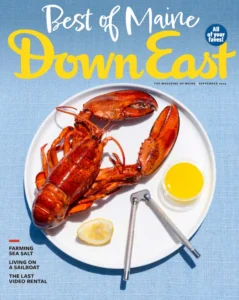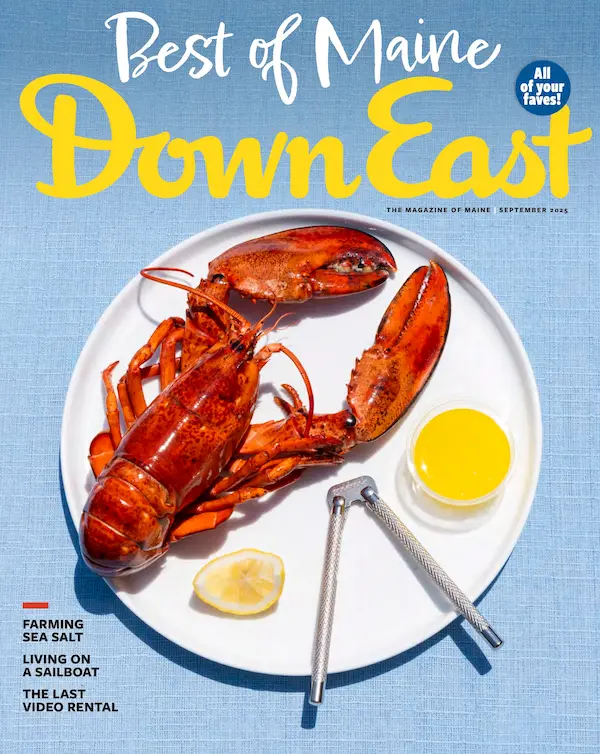By John H. Buchanan
From our October 1976 issue
Wendell Gilley of Southwest Harbor is a near-legend among admirers of carved birds. Over a period of 35 years, he has produced more than 6,000 carvings, some selling for several thousand dollars. Owners of his work have included Presidents Truman, Eisenhower, and Nixon, Chief Justice Earl Warren, J. Edgar Hoover, Sam Rayburn, and David Rockefeller. His birds have been shipped to almost every country in Europe, to Canada and South America. Visitors to his studio have come from as far away as Africa.
One might suppose that, at 71, Gilley would feel a waning enthusiasm for yet another bird. Not so. Carving consumes his waking life. When not at work on a commission (he has a three-year backlog), he relaxes in front of his television with his 15-year-old cat Plato and whittles bodies for popular species such as chickadees, or he hikes through the woods to study and sketch his favorite subjects.
“Birds are the most important part of my life,” he says as he sits in his workshop surrounded by pictures of birds, stuffed birds, and carved birds-in-progress. The only non-bird-related item in his shop is a fraternity plaque from his short stay at the University of Maine in 1922. “Songbirds don’t especially interest me, though I’ve made a few,” he says. “My specialties are game birds and birds of prey.”

A pipe-smoking, bespectacled down-easter, Gilley is a quiet, almost shy man. Long after financial success would have allowed him to travel wherever he pleased, he remained on Mount Desert Island, his way of life influenced by a strong sense of heritage. His great-grandfather settled on Baker’s Island in the late 1770s; his maternal great-grandfather owned half of a three-masted schooner and spent his life at sea; his grandfather and father were plumbers.
Until 1954, Gilley, too, was a plumber. Fourteen years before, he had begun to carve birds as a creative sideline to an even earlier interest in taxidermy. Before embarking on his present career, he had done only one piece of professional carving, a State of Maine seal for the Northeast Harbor Library. For those 500 hours this work required, he received $500.
It was a trip to the Museum of Natural History, in Boston, that changed his life. There, seeing the work of Cape Cod bird carver Elmer Crowell, Gilley knew how he wanted to spend his life. “I decided to make a few birds and go fishing the rest of the time.” Needless to say, as a busy craftsman he has done little fishing since.
The early years as a carver were anything but easy. “There were no books on the subject back then,” Gilley recalls. “I wrote the first one. My learning was all trial and error, and my first bird looked like something a child might have hacked out.”
“The problem was never shapes. Those I knew because I hunted a lot, but I’d never painted. Didn’t know one color from another. How could you expect a plumber to understand mixing colors? And, of course, I didn’t realize how bad my first birds were until I had gained greater skill.”
Gilley felt he had progressed to moderate “success” when he began selling small ducks through Abercrombie & Fitch of New York. For a bird selling at retail for $7.50, he received $3.75. Today, one small chickadee — a day’s work — sells for $50; larger, more exotic birds go for many times that. The most expensive carving Gilley ever made was a large wild turkey that sold for $4,500, and a recent commission for a great horned owl brought $3,500.

Some carvers charge much more. Jack Drake, a New Mexico minister, received $15,000 for a green-winged teal not long ago, and Arnold Melbye, of Cape Cod, gets $1,600 for a chickadee. Still, Gilley believes that he and his customers receive a fair shake. “If my prices seem a bit high,” he says with a smile, “I’ve never had any complaints, and I just wouldn’t feel right charging any more.”
If a $50 chickadee represents a day’s work, Gilley earns only six dollars an hour, minus expenses. Couldn’t he do better as a plumber? “Well, you can’t take it with you,” he replies. “Besides, when I started out, I did it just for fun, never dreaming I could make a living at it.” In the end, he claims, the pleasures of his craft exceed his bank deposits. “My work has allowed me to meet some very fine people. Doubt that I could go into a state or city where I don’t know someone.”
Gilley considers his work a combination of art and craft. “Many people can carve and many can paint, but only a few can do both.”
His birds are born from blocks of Maine basswood, used because it is fine-grained, tough, and free of knots and pitch. “It’s hard to come by,” he says, “for not many of these trees are cut. About the only things basswood is used for are cheap furniture and carving.”
Working from a pattern, he carves the body and head with a knife; next, the wings. Then he burns or grinds plumage detail, which is first given a coat of primer paint and then a final painting in oils. He later attaches glass eyes bought from a taxidermy supplier, and casts the feet in lead or pewter. The finished bird is mounted on its perch, usually a twig or branch affixed to a driftwood base.

“Carving’s the easy part,” Gilley says, “but painting a tiny bird or one with complicated plumage can drive you half crazy.”
Size, in fact, constitutes one of the ironies of Gilley’s art. Ordinarily, he receives much more for a big bird, despite the fact that it is, in a sense, easier to make. However, he sometimes allows the frustration factor to influence his prices. One popular item over the years has been a pair of miniature woodcock, about an inch long, that must be carved from the end of a small stick of wood and then sheared off when completed. Painting these miniatures requires a tiny brush and the manual dexterity of a concert pianist. For a pair of these woodcock, Gilley charges $500.
Fortunately, most customers want something larger and more dramatic, such as an eagle or osprey, but these, too, can present problems. They can, for instance, be too dramatic. “One woman ordered an eagle with a duck in its talons. When she got it, she said, ‘I can’t stand to look at it,’ so she had me take out the duck and put in a fish.”
At other times, he has experienced what might be called a difference of artistic opinion with a customer. “I once made a purple finch for a woman, but she sent it back to be repainted. Even though I repainted it twice again for her, she still insisted that it didn’t ‘look like the bird that eats at my feeder.’ Maybe her bird was molting, or maybe some cat had pulled out her finch’s tail feathers. Anyway, she finally took it.”
No one should attempt to challenge Gilley’s knowledge of birds. What he hasn’t seen with his own eyes he studies in books. In one corner of his workshop is an extensive library to which he keeps making additions. When a book can’t pin down a species to his satisfaction, he makes research trips.
“A couple from Arizona came in one time,” he recalls. “The husband wanted a roadrunner, the state bird of Arizona, and his wife wanted a kiwi, a native of Australia. Since I’d never seen either one, I had to go to the Museum of Natural History in New York before I could start carving.”
However, regular field trips near his home are his favorite method of research and reward him with fresh experiences. “One day, I was out on Duck Island and saw a snowy owl some 25 yards away. I moved up within a few feet of it and looked it right in the eye. It looked straight back at me for a while, then stretched its neck and took off. That was a beautiful sight.”
There was a time, not long ago, when Gilley would have wanted to shoot an unusual specimen, bring it home, and stuff it. No longer. “I won’t shoot anything today. Perhaps as you get older, you mellow.”
Getting older doesn’t persuade Wendell Gilley to think of retirement. “I’ll keep carving,” he says, “just as long as my hands stay good and I can see.”




